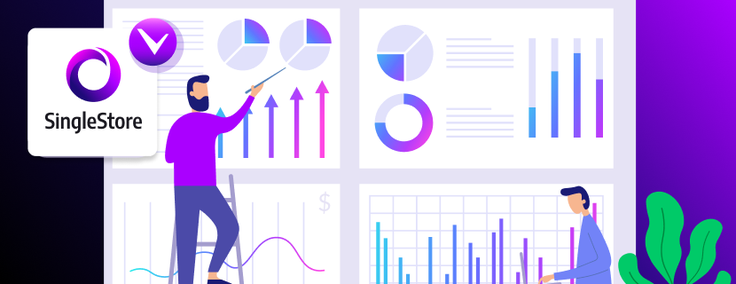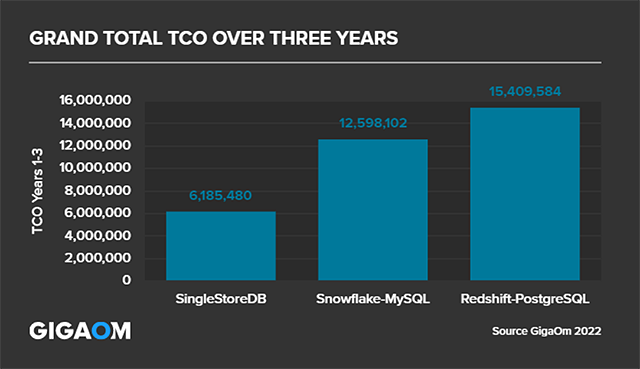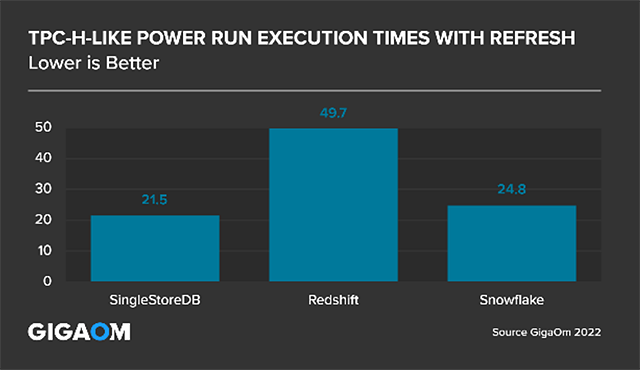
GigaOm recently conducted a Performance and Total Cost of Ownership (TCO) analysis which revealed that SingleStoreDB delivers better performance and a 50% lower TCO against the combination of MySQL and Snowflake, and a 60% lower TCO compared to the combination of PostgreSQL and Redshift.
Today’s enterprises are generating transactional data from all parts of their business. Modern SaaS applications, APIs and data products are the crucial digital touch points that must be responsive, interactive and real time to engage customers in data experiences that keep them coming back. At the same time, this transactional data must be analyzed and served to internal stakeholders managing operations, and embedded in these SaaS applications to enrich interactive customer data experiences.
This combined need to have both fresh, real-time operational and analytical data applies pressure from all sides, and in every moment. This is data intensity and it requires a new kind of database technology to solve it. SingleStoreDB is the #1 database for unified operational and analytical processing, and data intensity. With a single table type released in 2019 called Universal Storage and hundreds of customers in production using it, SingleStoreDB provides the best price-performance and TCO across the three industry standard benchmarks for transactional (OLTP) and analytical (OLAP) workloads: TPC Benchmark™ H (TPC-H), TPC Benchmark™ DS (TPC-DS), and TPC Benchmark™ C (TPC-C). While these do not measure all the dimensions of data intensity, they are an approximate baseline and are well understood.
The traditional approach for 50 years has been to use separate database technologies for OLTP and OLAP, mostly driven by limitations in hardware and cost. Enterprises built applications using operational databases and then copied the data to analytic databases for reporting. This created data silos and also increased the latency of the analysis of operational data. Beginning with the industry adoption of NoSQL databases almost 20 years ago, a growing trend emerged to pick more specialized databases for each workload. This increased the number of data silos immensely, duplicated data, increased data delays and cloud costs, raised security concerns, introduced new governance challenges and created unnecessarily complex data systems underneath SaaS applications. Today, that has culminated with out-of-control cloud complexity and cost, and is no longer sustainable and demands for data increase in every moment — especially as data intensity increases.
Innovations in cloud computing, hardware and database architecture design in recent years have invalidated the old assumptions that a single database technology can only perform a single workload well. SingleStoreDB is the industry leader in innovation and adoption for undefined transactions and analytics. It was built to simplify modern SaaS applications, save operational costs, reduce the number of database technologies to manage, provide consistent low-latency results and eliminate data movement.
This GigaOm report compares SingleStoreDB, a real-time distributed SQL database, to special-purpose analytic databases (Snowflake and Redshift) and special-purpose transactional databases (MySQL and PostgreSQL). This report combines both the TCO and benchmark analysis, so the economic buyers can review costs and share this with the technical evaluators who can review the validity of the claims in a single document.
What You’ll Find in the Report
The study compares SingleStoreDB as a distributed general-purpose SQL database to Amazon Redshift and Snowflake with two analytical workloads, and with a transactional workload. The purpose was to ascertain whether SingleStoreDB — as a multiple workload platform — performs at a level comparable to popular cloud databases.

Grand total TCO over three years (lower is better)
3 Key Takeaways
This report outlines the results from a GigaOm selection of tests derived from three industry standard benchmarks — TPC-H, TPC-DS, and TPC-C — to compare SingleStoreDB, Amazon Redshift and Snowflake. Some highlights from the report you’ll uncover include how SingleStoreDB delivers:
- 50% Savings over three years compared to Snowflake-MySQL stack
- 60% Savings over three years compared to Redshift-PostgreSQL stack
- Up to 100% Faster in TPC-H workloads compared to Redshift (with Refresh)
SingleStoreDB delivers transactional query performance competitive with purpose-built transactional databases, and analytic query performance competitive with purpose-built analytics databases — delivering both cost effectively from a single engine.

TPC-H-like power run execution times with refresh (lower is better)
Download the report today
Get the full rundown of how SingleStoreDB stacks up against major database competitors. Download your copy of the TCO and benchmark report here.





